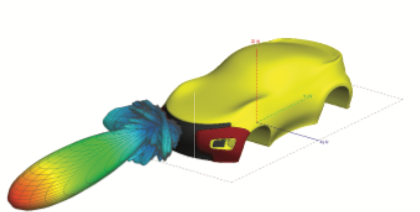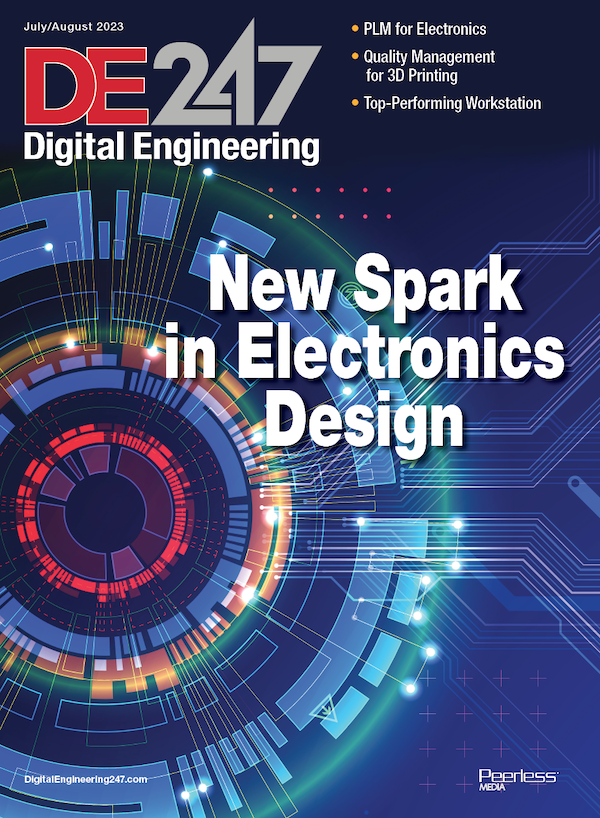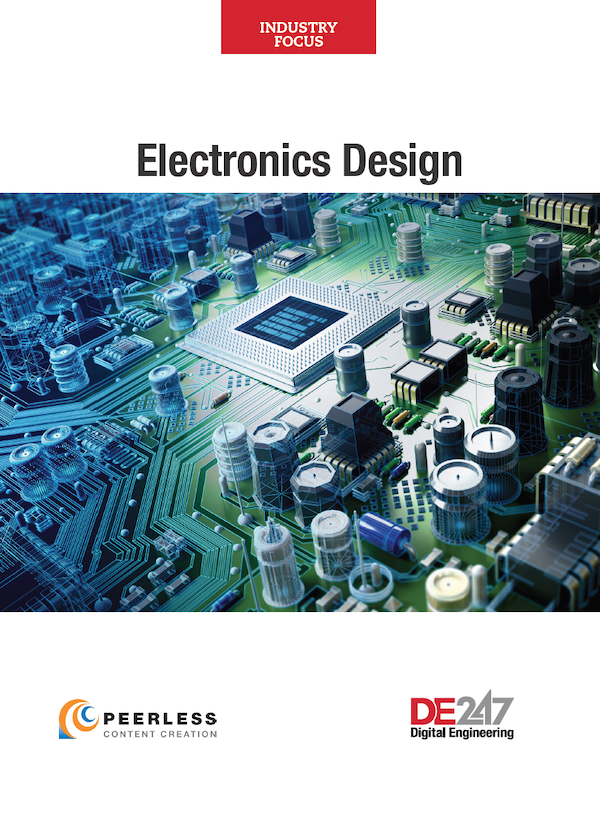
Altair Feko simulation drives the design of radar integration, including multiphysics (EM-mechanical) simulation with Altair OptiStruct. Image courtesy of Altair.
Latest News
January 1, 2019
A future filled with electric vehicles has captured the attention of the public imagination and automotive engineers around the world. Vehicle design is entering a new era, with advancements in powertrain, electronics, software and materials, as well as all-new engineering required to add autonomy and connectivity.
The Center for Automotive Research (CAR) recently published the first in a planned series of white papers (cargroup.org/wp-content/uploads/2018/07/Impact-of-ACES.pdf) on the implications of automated, connected, electric and shared vehicles. The initial “Impact of Automated, Connected, Electric, and Shared (ACES) Vehicles on Design, Materials, Manufacturing, and Business Models” paper focuses on passenger vehicles.
The Society of Automotive Engineers (SAE) has defined five driving automation levels. Each requires specific research in multiple fields. The five levels are listed below.
CAR defines ACES vehicles as: automated vehicles with SAE Level 4 or Level 5 capabilities; connectivity capabilities for vehicle-to-everything (V2X) communication, over-the-air (OTA) updates and in-vehicles customer services; battery-electric vehicles, including gas/electric hybrids; and shared vehicles that are managed by service providers that offer short-term on-demand access to vehicles that could be driven by the customer, a third party or by a computer.

Future vehicle design needs to rethink most existing notions regarding the form and function of transportation. The space given to motors and powertrains is only the most obvious of many concepts challenged by new electric vehicles. Image courtesy of Dassault Systèmes.
CAR interviewed experts at six of the top 10 automotive manufacturers, 12 Tier-1 suppliers and one “new mobility” company, Ridecell. All were asked to share their opinions on the potential impact of ACES \n by expected regulatory requirements. Energy prices are expected to be the primary driver of lower adoption of BEVs in North America.

The five driving automation levels, according to the Society of Automotive Engineers. Click here for larger image.
The study says the most aggressive estimates for Level 4 or Level 5 autonomy have the first vehicles deployed in 2020, but the majority of experts think 2030 is a more realistic expectation. The first deployments are expected to be for shared fleets, not personal ownership. All adoption estimates consider fleet turnover, which has been rising in recent years.
The Shape of Cars to Come
Although all phases of automotive engineering affect ACES development, body design will attract the most attention. Function and aesthetics will be the two main body design drivers. An automobile designed for urban shared use may look like a rolling shopping cart while long-haul vehicles will probably be spacious, styled for highway-speed aerodynamics, and filled with comfort and connectivity features. Some experts believe external aesthetics will be a secondary design issue for shared vehicles: “People in general don’t value the aesthetics of things they do not own,” the CAR report states.
The CAR report expects powertrain components to become a commodity. “Unique brand identity could shift from powertrain performance to other components,” the report notes. “Fewer opportunities for differentiation exist in an electric powertrain.” Manufacturers would be better served by sharing powertrain technology and investing more in interiors, software and services, and style. “Only the control unit and software will remain a core competency of the automakers,” the report explains.
Batteries provide an opportunity for structural design differentiation. Tesla talks about its “frunk,” or second trunk in the front, replacing the combustion engine. Batteries are cells that can be stacked and arranged much like Lego bricks, and can be used for stability and crash protection. Battery thermal hazards will require new materials and new structural design considerations.
The most complicated new research and engineering will be in materials, the report says. First-generation ACES vehicles will likely use materials that are common today, but increased use of fatigue research and lightweighting from aeronautics will drive second-generation designs. “Aerospace fatigue standards could serve as a starting point for future automotive durability standards,” according to the report. Materials research will also need to solve for protecting the wide variety of sensors (LiDAR, radar and vision/aural systems) that ACES vehicles require. “Even routine activities such as car washing can pose a threat to sensors,” according to CAR.
Lightweighting will require new thinking, the study claims. Despite the use of lighter parts, automobiles have not been getting lighter in recent years. Some models are increasing in weight. Much of the increase is due to demand for comfort and entertainment features.
Serving with Software
Engineering software vendors are well aware of the CAR report and the new demands facing the automotive industry. “Twenty years ago, a model had six years to test, verify and validate,” notes Michael Lalande, North America director of the Transportation Mobility Industry Group at Dassault Systèmes. “Twenty years ago a vehicle had a (bill of materials) that was 80% mechanical, 10% electronics and maybe 10% software. Today, autonomy requires a BOM that is 40% mechanical, 40% electronics and 20% software.” Such a major shift in the bill of materials brings “completely different challenges,” Lalande adds.
With so many new challenges, where does the engineering team begin? Lalande says start with the batteries. The industry has years of experience with batteries for hybrid vehicles; “now the trend is for full battery,” he notes.
Dassault has software for analysis, simulation, verification and validation of battery chemistry, packaging and placement. A “systems of systems” approach, Lalande notes, is required to include such elements as winter vs. summer impact on battery performance, weight and performance, Restriction of Hazardous Substances (RoHS) issues, and managing content, from cradle to grave.
Internally, preparing for ACES engineering required Dassault Systèmes to re-evaluate its product line with the “buy or build” metric. The recent acquisitions of Exa Corporation (computational fluid dynamics) and No Magic (software systems development) occurred in preparation for ACES engineering.
Siemens PLM Software has also built up its CAE portfolio with the ACES revolution in mind. The Fibersim and Simcenter software portfolios have been assembled from a combination of existing Siemens PLM Software CAE products and acquisitions including CD-adapco and Mentor Graphics. “ACES has been a nice driver to speed the integration” of recent acquisitions, notes Dave Lauzun, VP of Automotive and Transportation Strategy at Siemens PLM Software. “(ACES vehicles) need tight integration between mechanical and electric design.”
Lauzun says Siemens PLM Software is seeing companies take a two-prong strategy to automotive design, present and future. “While developing a Level 4 fleet, companies still must pump out hundreds of thousands of profitable cars, trucks and SUVs,” he says.
New Design Tools Put to Use
Such a split strategy provides the opportunity for companies to explore new software tools without disrupting existing workflows. Lauzun says Siemens has invested significantly in generative design technology, which uses a combination of brute force calculation and artificial intelligence to rapidly examine design alternatives.
“Use the laws of physics and forces of nature,” Lauzun says when describing generative design. Lauzun sees generative design as particularly useful for designing new hybrid systems architectures, electrical architecture and wiring harness systems.
Significant engineering will also be required for the new manufacturing systems needed to produce ACES vehicles. “The wide range of materials and joining is a big deal,” notes Lauzun. “Much more than spot welds with robots will be required.” New materials and designs will require specific joining methods, while constant customizations may require a new generation of automated guided vehicles in the factory to deliver materials and tools, summoned not by a person but by the workflow software managing the assembly line.
A third line of investment for Siemens PLM Software to prepare for ACES engineering is new tools for noise, vibration and harshness (NVH) analysis. “NVH for ACES (vehicles) creates challenges from start to finish in an automotive facility,” Lauzun says. “We continue to acquire companies to help address these needs.”
Another company merging existing and acquired software tools to support ACES engineering is Altair. The company has customers using its FEKO and OptiStruct simulation tools to drive the design of radar integration into ACES vehicles.
“Customers are using HyperWorks to drive ADAS (advanced driver-assistance systems) and autonomous sensor designs with simulation,” says Anthony Norton, VP of Americas, technical operations for Altair. “Not just for detailed antenna and radome design with Altair FEKO, but additionally multiphysics explorations and EM-mechanical simulation with other Altair solvers, for sensor integration and protection.”
Subscribe to our FREE magazine, FREE email newsletters or both!
Latest News
About the Author
Randall S. Newton is principal analyst at Consilia Vektor, covering engineering technology. He has been part of the computer graphics industry in a variety of roles since 1985.
Follow DE






